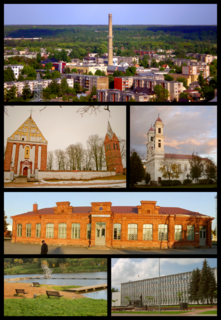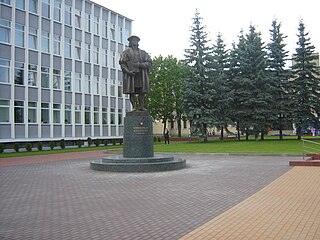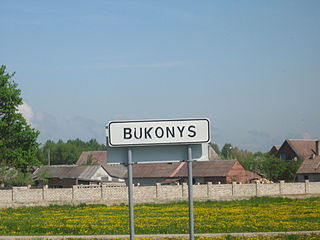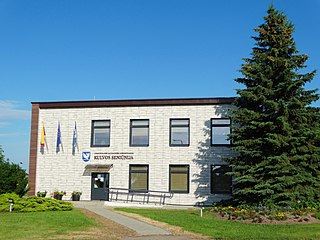
Jonava (pronunciation is the ninth largest city in Lithuania with a population of ca 30,000. It is located in Kaunas County in central Lithuania, 30 km north east of Kaunas, the second-largest city in Lithuania. It is served by Kaunas International Airport. Achema, the largest fertilizer factory in the Baltic states, is located nearby. The city is sometimes called "the capital of midsummer holiday".

Jonava District Municipality is one of 60 municipalities in Lithuania.

Paweł Holszański was a notable Catholic church official and one of the last male scions of the once-mighty Lithuanian Olshanski princely family of the Grand Duchy of Lithuania.

Abraomas Kulvietis was a Lithuanian jurist and a professor at Königsberg Albertina University, as well as a reformer of the church.

Upninkai is the largest village in Jonava district, Lithuania. It is situated 8 km southwest of Vepriai on the left bank of the Šventoji River. According to the 2011 census, it had population of 786.

Albertas Goštautas was a Lithuanian noble of the Goštautai family from ethnic Lithuanian lands of the Grand Duchy of Lithuania. Voivode of Navahrudak since 1508, Voivode of Polotsk since 1514, Voivode of Trakai since 1519 and Voivode of Vilnius since 1522. In 1522 he became Grand Chancellor of Lithuania. He was the initiator and the editor of the First Statute of Lithuania, as a successor of his staunch opponent Mikolaj Radziwiłł, who rivaled him in the precedence in the Council of Lords. His subsequent rival in influence in the Grand Duchy was Konstanty Ostrogski.

Stanislovas Svetkus Rapolionis was a Lutheran activist and Protestant reformer from the Grand Duchy of Lithuania. With patronage of Albert, Duke of Prussia, he obtained the doctorate of theology from the Protestant University of Wittenberg where he studied under Martin Luther and Philip Melanchthon. After graduation, he became the first professor of theology at the newly established University of Königsberg, also known as Albertina. As professor he began working on several Protestant publications and translations, including a Bible translation into Polish. It is believed that he also started the first translation of the Bible into Lithuanian. Together with Abraomas Kulvietis, Rapolionis was one of the first authors to write in the Lithuanian language. While Rapolionis and Kulvietis died early leaving their work unfinished, they laid the foundations for future Lithuanian writers and translators.

St. Anne's Church is a Roman Catholic church in Vilnius' Old Town, on the right bank of the Vilnia River established circa 1495–1500. It is a prominent example of both Flamboyant Gothic and Brick Gothic styles. St. Anne's is a prominent landmark in the Old Town of Vilnius that enabled the district to be included in the list of UNESCO World Heritage sites, and is one of the most interesting examples of Gothic architecture in Lithuania.

Bukonys is a village in Jonava district municipality, in Kaunas County, in central Lithuania. According to the 2001 census, the village has a population of 657 people.

Baltromiškė is a village in the Jonava district municipality, in Kaunas County located in central Lithuania. According to the 2011 census, the village has a population of 19 people. There is a church of Old Believers. The village is famous for gravel mines.

Bartoniai is a village in Jonava district municipality, in Kaunas County, in central Lithuania. According to the 2011 census, the village has a population of 197 people.

Bazilioniai is a village in Jonava district municipality, in Kaunas County, in central Lithuania. According to the 2011 census, the village has a population of 42 people.

Išorai is a village in Jonava district municipality, in Kaunas County, in central Lithuania. According to the 2011 census, the village has a population of 475.

Jaugeliškiai is a village in Jonava district municipality, in Kaunas County, in central Lithuania. According to the 2011 census, the village has a population of 63 people.

Juškonys is a village in Jonava district municipality, in Kaunas County, in central Lithuania. According to the 2011 census, the village has a population of 385 people.

Šilai is a village in Jonava district municipality, in Kaunas County, in central Lithuania. According to the 2011 Lithuania census, the village has a population of 347 people. Administrative centre of Šilai Eldership.

Vaivadiškiai is a village in the Jonava district municipality, in Kaunas County, in central Lithuania. According to the 2011 census, the village has a population of 167 people.
Jurgis Zablockis was one of the first known writers in the Lithuanian language. Two hymns that he translated from German to Lithuanian were published by Martynas Mažvydas. One of them was published in Simple Words of Catechism, the first printed book in the Lithuanian language. He earned a living tutoring sons of the nobility and frequently accompanied them to Protestant universities in Germany. He was a tutor to Martynas Mažvydas and Bishop Merkelis Giedraitis.

Kulva Eldership is a Lithuanian eldership, located in a western part of Jonava District Municipality. As of 2020, administrative centre and largest settlement within eldership was Kulva.

Pėdžiai is a village in Kėdainiai district municipality, in Kaunas County, in central Lithuania. According to the 2011 census, the village had a population of 80 people. It is located 2 kilometres (1.2 mi) from Nociūnai, by the Barupė river, between the roads "Jonava-Šeduva" (KK144) and A8. There is a cemetery and a pond.



















